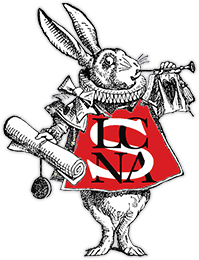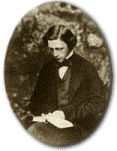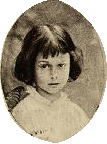The information below is intended to address some frequently asked questions about Lewis Carroll, but is by no means intended to answer all questions.
For more about Lewis Carroll and his works, please visit our Lewis Carroll Resources page. You are welcome to submit news of a Carrollian nature to our Blog.
See also, LCSNA FAQ.
About Lewis Carroll
Who exactly was Lewis Carroll?
Charles Lutwidge Dodgson, known by his pen name, Lewis Carroll, was a man of diverse interests—in mathematics, logic, photography, art, theater, religion, science, and of course literature. He was happiest in the company of children for whom he created puzzles, clever games, and charming letters. And of course, he also told them stories.
As all Carroll admirers know, his book Alice’s Adventures in Wonderland (1865), became an immediate success and has since been translated into more than eighty languages. The equally popular sequel Through the Looking-Glass and What Alice Found There, was published in 1872.
The “Alice” books are but two examples of his wide ranging authorship. The Hunting of the Snark (1876), a classic nonsense epic, and Euclid and His Modern Rivals (1879), a rare example of humorous work concerning mathematics, still entice and intrigue today’s students. Sylvie and Bruno (1889), published toward the end of his life, contains startling ideas including a description of weightlessness.
The humor, sparkling wit and genius of this Victorian Englishman have lasted for more than a century. His books are among the most quoted works in the English language, and his influence (as well as that of his illustrator, Sir John Tenniel) can be seen everywhere, from the world of advertising to that of atomic physics.
Why did Mr. Dodgson write under the pen name of Lewis Carroll?
As a modest gentleman and a scholar/instructor at Oxford, he valued his privacy very highly. He would refuse letters sent to “Lewis Carroll, Christ Church, Oxford”, claiming no such person lived there! But he did occasionally use his pen name to smooth an introduction to a well-known member of society or new child friend.
How did he come up with the name Lewis Carroll?
He took the first two parts of his name, Charles Lutwidge, and translated them into Latin: Carolus Ludovicus. He then reversed their order: Ludovicus Carolus, and then loosely translated them back into English: Lewis Carroll. He actually supplied his first publisher with a short list of possible pen names, and it was the publisher who selected “Lewis Carroll” from the list. Share that bit of trivia at your next mad tea party!
Was there a real Alice?
Indeed there was. Alice Pleasance Liddell was arguably Charles Dodgson’s greatest child friend. She was one of the daughters of Henry George Liddell, Dean of Christ Church, Oxford, where Mr. Dodgson lived, taught and wrote.
Was Lewis Carroll in love with Alice?
To say that much has been written on this question would be a monumental understatement. For the purposes of this site, suffice it to say that in addition to being a friend during her childhood years, she was his first true creative muse. Interestingly, Alice Liddell also inspired a number of other well known artists of the time, including John Ruskin, William Richmond and Julia Margaret Cameron. The fact that the two “Alice” books are still so beloved today stands as a testament to the lasting power of that original inspiration, and to Mr. Dodgson’s timeless genius.
What was the origin of the Alice books?
Mr. Dodgson would often take young Alice and her sisters Lorina (older) and Edith (younger) on leisurely rowing expeditions in the company of a fellow Oxford scholar. During these boat rides and subsequent picnics, he would make up fantastical tales to entertain the girls. What we now know as Alice’s Adventures in Wonderland began as one of these stories, and was only written down because Alice begged Mr. Dodgson to do it. The first version, which he wrote and illustrated by hand for her, was entitled Alice’s Adventures under Ground. Some of the most famous chapters of Alice’s Adventures in Wonderland were actually written only after his friend (and noted children’s author) George MacDonald and his family encouraged Mr. Dodgson to explore the idea of expanding and publishing the story so that more children could enjoy it. Alice’s Adventures in Wonderland met with instant success, as did its sequel, Through the Looking-Glass and What Alice Found There.
Can Lewis Carroll’s creativity and writings be explained by any possible drug use, epilepsy, migraines, or other mind-altering circumstance?
In brief: no, no, no, and no. Based on all evidence unearthed to date, unless you count the occasional use of an over-the counter homeopathic remedy, Lewis Carroll was not a drug user. This may disappoint lazy media hounds, but that’s the truth as we currently know it, and given Carroll’s abstemious personality and conduct, that particular finding is unlikely to change. Similarly, while he had a couple of seizures of one kind or another in later years, and wondered if one of them might be “epileptiform” in his diary, he also recorded afterward that his own doctor told him that it was not, and there was no history of it in his immediate family line. And while he records that he occasionally had a very bad headache, including some descriptions that sound like migraine symptoms, we have no hard facts that could lead one to say uncontestably that he suffered from migraines. Seizures and severe headaches can be caused by any number of things, and providing a medical diagnosis more than 100 years after the fact is not advisable. It’s fascinating what people since Carroll’s time have tried to read into his life after reading his remarkably inventive works. Our explanation for how the Alice books, the Snark, and all Carroll’s other writings came to be is simple: the man was extremely talented.
Where can I find out more about Lewis Carroll?
You can find extensive information about Lewis Carroll on our Lewis Carroll Resources page.
See also, LCSNA FAQ.




